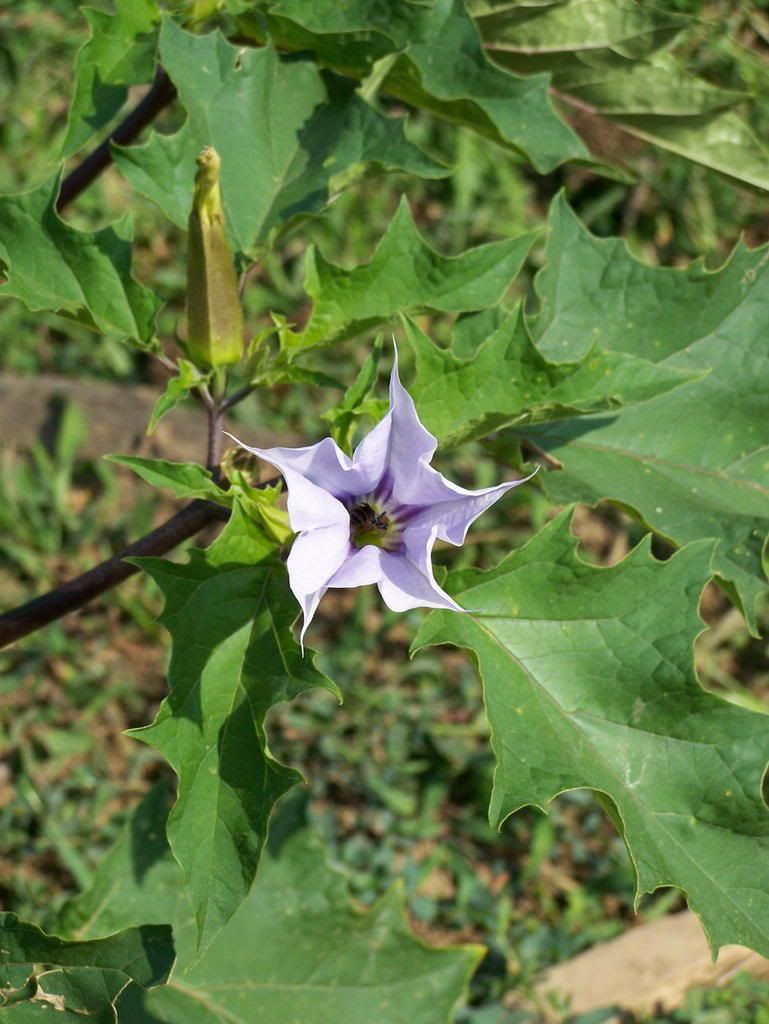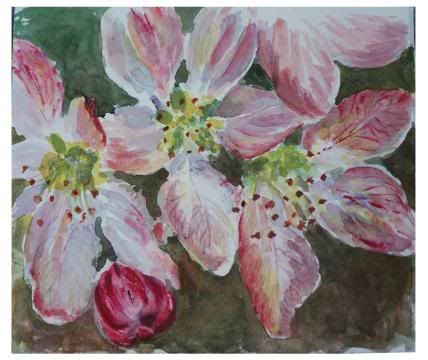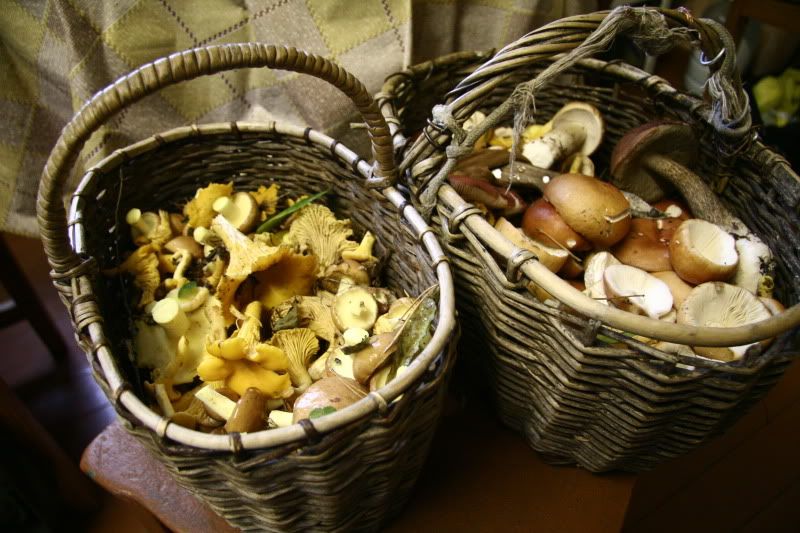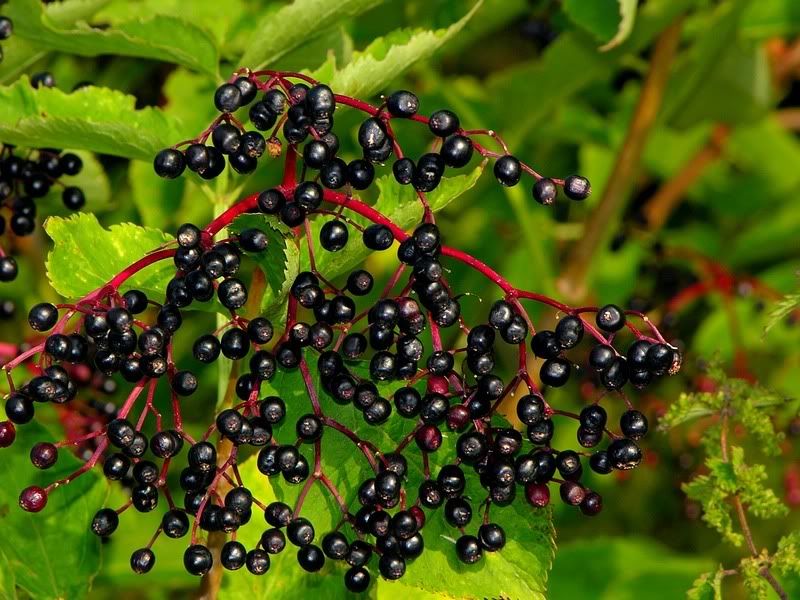
Variegated Solomon's Seal (Polygonatum falcatum 'Variegatum' formerly P. odoratum 'Variegatum' or P. odoratum var. thunbergii 'Variegatum') loves shade to deep shade, & moist humusy soil.
The species ranges from Europe to Asia; the variegated form is of garden origin, from Japan.
Though the root has been used as a potato-like food source, & shoots prepared as a kind of asparagus, the whole plant but especially its roots & berries are sufficiently toxic that it can be dangerous to prepare, though harmless if properly & entirely well cooked.
Solomon's Seal If a rhizome is disturbed, divided, or separated from the parent plant in autumn for propogation purposes, it can be slow to recover, producing only a little foliage for the first year or two. When it has finally readied itself to take off, it becomes a stunning clump of graceful arching maroon stems lined with white-edged foliage.
The variegated form can be a little smaller than the regular species, often remaining in the fifteen to twenty inch range of height, but larger is possible in time. Once the rhizome has reached its way all about the area, the clump will erupt in spring three or four feet wide.
By then it will be too aggressive for anything nearby that is small to coexist, though hostas hold their own perfectly well, & Solomon's Seal does not displace anything larger, having evolved to live in the shelter of larger shrubs & trees.
It is grown primarily for the foliage, since the cream-colored flowers are small dangling bells mostly hidden on the underside of the long arches of large leaves. These graceful two-foot stems of leaves are useful in flower arranging.
Despite that the flowers are not as showy as the foliage, they are even so very pleasant in May, small bells hanging in pairs under the arching stems at each leaf axil. A bit of green speckles the tip of each bell.
Solomon's SealIn England Solomon's Seal is sometimes known as David's Harp, after medieval religious art which portrayed David with an instrument hung with metal bells (similar to the plant's dangling blossoms) struck with hammers. This is not the usual image evoked of David's biblical instrument, but it is seen on such monks' art as in the Plock Biblio parchment of 1148.
So too a Psalter in the Arundel collection has an illumination for the Eighty-first Psalm (which speaks of the harp) showing David striking a row of silver bells with hammers, this having been a Saxon influence of what David played. Wind chimes are likewise sometimes called King David's Harps.
In authentic Jewish sources, as well as most Christian, the harp really is a harp & not a belled instrument. But reproduced here is an illumination from the Gallican Psalter of 1470 showing David playing the bells (but with his harp leaning on a stool behind him, & lutes on the wall) & enclosed in vines.
The reason for its more common name is not entirely certain, because assigned to the plant a great long while ago. The predominant theory regards the starchy rhizome which grows each year another branching segment, with a "scar" left between each segment.
This root-scar is thought to be the reason for the name "Solomon's Seal," the plant sealing itself at each juncture leaving a mark some have likened to a Star of David. Additionally, it was once believed that juice from Solomon Seal roots possessed this same capacity to seal wounds of battle, just as it sealed its own wounds.
Solomon's SealPart II:
King Solomon & His Signet Ring
A tale of King Solomon & his seal is worth retelling, drawn in part from Mirkhound's Rouzat-us-Safa, & Tabari's History.
Djarada, the daughter of the legendary King Nubara of India, raised an army against Israel, & was killed in battle by King Solomon. King Nubara's daughter was forced into King Solomon's harem. She so despised her father's slayer that she wept constantly over her fate.
To appease her, Solomon allowed her to keep an idol of her father & worship it in her chambers. Public criticism caused him to change his mind. He broke Djarada's idol, punished her for idolatry, & underwent pennance for his own weakness in catering to his wife's sorrows & whims.
Leningrad CodexFrom Djarada's point of view, the slayer of her father could not even keep a promise to permit her her own faith. But Solomon adored her for her beauty &, hoping finally to win Djarada's affection, loaned her the signet ring by which he ruled, upon which was emblazened the six-pointed star of his & King David's realm, shown together with the Tetragramaton which spelled out the secret name of God.
Or according to others, Djarada held the ring for Solomon whenever he went to the privy. Still others ascribe this incident to a handmaiden, Aminah, who was given the ring to hold whenever Solomon was in his bath. For whatever the reason, she was at times entrusted with the very ring that permitted Solomon to rule Israel & even to command demons & demonesses to do his bidding.
It transpired that a demon named Ashmodai or Asmodius, or a djinn called Sakhur or Haritsu, took notice of this transaction. Taking on Solomon's form, he asked Djarada for the ring. When the real Solomon returned to Djarada's chamber, asking where she had put the ring, she immediately suspected him of being a demon & cast him out of the palace. But it is possible that Djarada conspired with the djinn from the beginning, to avenge her slain father.
Solomon went from house to house claiming to be the king of Israel, but people laughed at him. One housewife took pity on his delusion & gave him a plate of parched barley, but no one else paid him any attention [Ruth Rabbah 5:6; Eccl-Rabbah 2:2]. As he ate the barley, he wept at such irony, saying, "This is my portion from all my labor" [Eccl 2:10] when formerly his provisions for a single day consisted of thirty measures of fine flour, sixty of meal, ten fat oxen, twenty cattle, a hundred sheep, besides harts, gazelles, roebucks & fatted foul [1 Ki 4:22-23].
In those better days, so much was made for him to eat because all is wives prepared him meals, each hoping it was she that would receive him in the evening [Eccl-R 9:11.1]. But now here he had only a plate of mashed beans or barley, from a housewife who had wacked him on the head for claiming to be king of Israel.
Ashmodai threw Solomon's seal into the ocean, for the name of God upon it burned the fingers. While he was pretending to be king, he never removed his stockings, for he could not disguise his demonic feet, which were either hairy, or like a chicken's.
He would go to Solomon's wives, wearing stockings, & lay with them when they were menstruant. He even called for Bathsheba, but she would not lay with him, but set before him the name of God, so that he fled from Bathsheba's radiance [b. Gittin 68b].
Solomon and ShulamitAccording to the Midrash Tanumah, the first of Solomon's wives to uncover Ashmodai's masquerade was Topos. The majority of Solomon's court was continuously fooled.
The Jerusalem Talmud, however, says it was an angel of heaven, & not a demon, who took Solomon's throne, while Solomon wandered in chastized circumstance. It had been angels of God who gave Solomon his power over demons & demonesses. So when he worshipped foreign gods for the sake of his wives, it was angels of God who took away his power to command demons & demonesses.
In his misery, Solomon fled to the land of Amon, where he served as chief cook & bottlewasher for the Amonite king & queen, seething whenever he thought of his riches "lost in a bad venture"Ý[Eccl 5:14] or whenever he pondered the demon who usurped his wealth, possessions, & honor [6:2].
While he struggled for no further gain than to eat [5:12], Princess Naamah noticed his suffering, & fell in love with him. Her mother & father were outraged that their daughter desired to marry a kitchen worker. They exiled her from Amon, along with Solomon. Yet they were happy, & Solomon said, "Two are better than one, because they have a good reward for their toil" [4:12] & "If two lie together, they are warm" [4:13].
After numerous shared adventures, Naamah found Solomon's signet ring in the belly of a fish she was preparing for their repast (an almost identical legend occurs also in Indic mythology). By the seal on the ring, Solomon was restored to his throne. He cast out Djarada as a betrayer or a fool, & made Naamah his co-ruler seated beside him in her own throne [Bet ha-Midrash II:86-87; Midrash Tehillim 78:12].
However, Solomon never entirely overcame his fear of the demons & demonesses that had once been his to command by the power of the Seal. He worried that creatures of darkness would come against him as he slept, & so built a special bed, stationing three-score armed men around it [Song of Solomon 3:7], convinced as he was that he would be attacked by "the Dread (Pahad) of the night" [3:8]. Pahad of the Night was a title for the fierce charioteer & night-demoness Agrath, who is called "the Terror (Pahad) that walketh by night" [Ps 91:5; Numbers Rabbah 12:3].
Part III:
Origin: Emblem of the Mother Goddess
Solomon's Seal or the Star of David originally signified a Goddess akin to Ishtar or Anath. She may have been worshipped by the name Megiddo, which means "Her Eminance" or "Fruitful Lady" or "Mountain Mistress" or "Towering Lady." In Palmyrene inscriptions, Iddo, "Mistress" or "Lovely," occurs as a personal name, which is the feminine counterpart of the Syria God Haddu (Adu) known to the Hebrews as Hadad (Adon), "Lord." Baal Hadad's sister-consort was Anath, the Syriac Athena, & Megiddo must have greatly resembled Anath.
AnathIsaiah said that Megiddo's mountain was the "mount of congregation" ruled by "the son of the Morning Star" [Isa 14:12-14], this star being the same as the Star of David or Solomon's Seal.
Pagan divinities gathered at Megiddo's mountain in obeisance to Her, hence in rival cults Megiddo's mountain was called Armageddon, where the armies of the Antichrist gather in preparation for their battle with the armies of the Christ [Rv 16:16].
Among ivory carvings found by archeologists at the ruins of Megiddo was one of a slender nude woman with queenly headdress, & another of a robed woman. The robed woman carries an oversized staff of authority. Her large eyes are inset with glass & she is distinctly smiling, as though blessing those who gaze on her. She shows an Egyptian influence, somewhat resembling Isis. This would seem to be the original Megiddo, before she became a symbol of Doom & Armageddon at the end of time; although, like Kali, she may always have been as much the mark of the end of time as she had been the mark of the beginning of time.
The earliest Star of Davids discovered by archeologiests have come from Megiddo & Gibeon, where unique temple configurations were found to be held in common. The Gibeon Star of David occurs on a woman's cook-pot, & within it is a pictograph of a hen, while the Megiddo example is on a monument. This star, as a symbol of Megiddo's presence, may for the most part have been drawn with red paint as a devotional offering. This would explain why so few Star of Davids survive from greater antiquity, the paint having washed away with time. Indeed, until these two stars were discovered, it was commonly believed not to have been an ancient symbol.
It is easy to imagine that these painted stars, in a later age when Megiddo was no longer widely known as a Goddess, were reinterpreted as Solomon Seals, painted in pagan places by Solomon himself in order to seal in the demons that had once been the gods & goddesses symbolized by just such star-symbols.














